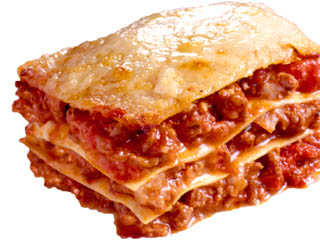Slappa CD cases rock! I use them for my CDs, and now finding the perfect next tune in my CD collection is 100 times easier. Check them out!
Now with 5% off if you use the link above or enter "Recess" in the discount area!
Removing Vocals or beats from a track
It's almost impossible
Sorry
Towards the end of the book, there's a chapter about frequent questions I've been asked over the years. Probably the most common mis-conception is that there's a mystical way to be able to remove either the vocals from a tune to leave beats, or to remove the beats to leave only the vocals. The truth is that simply removing one element or another is impossible. Yes, there's 'other ways' around this, which can give a similar effect, but you can't take a tune, and strip out the vocal, leaving a pristine version of the original. I'll explain why first, then I'll go into what else you can try.
It's all about lasagne
Think of a tune like a big dish of lasagne. In order to make even the most basic lasange (or a tune) you need certain ingredients:
- Mince (Drums)
- Tomato (Bass Sounds)
- Pasta (Melody/Hook)
- Onions (Effects)
- Cheese (Vocals)
When each of these ingredients are in their bowls, before you mix them together and cook 'em, you can do whatever you want to them. You can make them bigger, small, spice it up, cool it down, pre-cook the mince, add different kinds of chesse - whatever you want - but the key moment is when you mix the mince, tomato and onions together, layer on the pasta, then layer on the cheese and throw it all in the oven for 40 minutes. Once you've done that - you've made a 'mix' of all the ingredients, and have made something which is a combination of all the parts.
Why does this matter to you? Well, say you have a lasagne in front of you, and you think 'Hmmm, I only like the mince and tomato part of a lasagne - I don't like cheese, pasta or onions' - if you try to go into the pot and remove JUST the mince and tomato, two things will happen - you'll not be able to take out just the mince and tomato - little bits of cheese, pasta and onion will be there too, along with the general taste of those three unwanted items - but also, you'll leave loads of mince and tomato behind, so what you'd have wouldn't be the full amount anyway.
Or, think about just wanting to remove the vocals (cheese) from the lasagne. Sure, you might have made a simple lasagne, and just put one layer of cheese on top of the mince etc, but you won't be able to peel off just the cheese, it's been baked in with the rest of the dish - when you peel it off, you'll leave loads behind, and loads of the rest of the lasagne will come with it - there's no clean way to get just the cheese - and remember, it's been baked too - so it already contains loads of the sounds (tastes) of the rest of the track - so even if you were 100% tidy, and could peel it off cleanly, the rest of the tune is now 'Baked into' the vocals.
That's a hell of an analogy, huh?

The Workarounds
There are options
So, hopefully my lasagne analogy has got across how hard it is to remove just the vocals, or just the beats from a tune - but that doesn't mean there's no way you can get around this. Here's a few options.
Editing with software
Depending on what your use for the tune is, and how it's originally been recorded, you may be able to use some audio editing software (like Adobe Audition, NGWave etc) to do a 'patchwork' of the original tune. Not all tunes have vocals running all the way through them - there may be beat intros with just the bass, breakdowns with out the beats and bass drums, outros which are the chorus without vocals over them - or other points in the tune where there aren't already vocals. Each time you find one of these parts, save it to a folder on your hard disk and name what the element is.
You'll need to be sure you're taking the right length of 'chunk' though so you can replicate it enough. If there's 16 bars of beat intro, make sure to take the entire 16 bars, so you can loop them over and over, to create a constant beat if you wish - don't just take 14 bars, and try to loop that, as it'll sound terrible. If the last 4 bars starts to have a vocal intro to it - you might consider only taking 8 bars of beats, and working with that. Just try to make sure to always lift out in multiples of four bars. One bar may be ok if only played from time to time, but be careful if you intend to repeat one bar over and over for 5 minutes.
If you're unsure about what a bar is, and how it's made, either look at the book, or the Beats and Bars page on this website
Removing vocals using the stereo field
Still in the software realm, you can sometimes find a vocal remover effect (Cool Edit had this) which uses stereo information to remove the vocals. The principle is simply that most music is 'panned' left and right to create a stereo sound, but most vocals are left 'centred' so they appear in the middle of your head. The software simple calculates what information has been send independently left and right, and what's been left in the middle - and removes everything in the middle.
This, however, has differing results. If you try it through a whole tune, you'll find some parts are better than others for a start, but you'll also find that it sounds as though it's been recorded underwater. This is simply because lots of the 'ingredients' are still left playing 'centred' in the tune, so they get removed as well (the tomato stuck to the underside of the cheese). Or, as backing vocals are still often panned left and right, though you'll have lost most of the main vocal with this technique, you'll still hear the backing vocals in the stereo field.
So, it comes down to what part of the tune you're trying to remove the vocal from, and more importantly, simply the tune you're using. If you have a program that can do this, try it with several tunes, and you'll see what I mean.
Using EQ's
If you have access to a huge bank of EQ's (not just the Hi, Mid and Low on your DJ mixer) you can often isolate a tiny part of a vocal, and keep it - but you still won't be able to remove the vocal and keep a plain beat. I mention in the book a friend of mine in a band called "Pacifica" who used the vocal sample from Heart of Glass by Blondie. It's simply the "Ooo ooo Aaaah Aaaah" thing she does. In Heart of Glass, there's one bar where she sings it with very little else going on, just drums I think. Well, Donald and the engineer spent a LONG time in the studio with a bank of effects and EQ's trying to filter out all the unwanted sounds to give as clean as possible a version of the sample. In the end, you can still faintly hear the hi-hats from the original tune playing, but as it's over music from the Pacifica tune, that's not too much of a worry.
A capella's and instrumentals
This is probably why you're thinking of this in the first place. You'll have heard either the vocal from a track playing over another tune, or you'll have heard just an instrumental version of the tune. There's no 'skill' involved in this, it's simply that when that tune was being recorded, and they still had access to all of the ingredients that made up the tune (unmixed) - they were able to create an instrumental, or a cappella (only the vocals) version. How often these get made, and whether they ever get a general release, who knows - but it's the easiest, simplest and most common 'way' to get the vocals or music only.
I guess the other option is to get someone to sing the vocal line that sounds exactly the same as the original - but that's pretty unlikely.
Clear?
I hope this cleared up the myth that this is something you can do - in the end, the best option is probably to go for a mixture of remixing just the instrumental/beat parts of a tune (or a remix of it which might be elsewhere on the CD/Vinyl) using software along with using the stereo field removal technique for certain parts, if you REALLY have to use them
Good luck with it all, and if you've got any other tricks on how to do this, please get in touch.
Click above to choose to buy the book (if you want to) from Amazon - US - UK - or Canada


